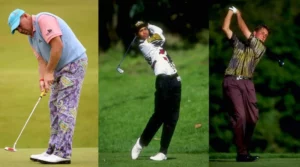A Rich Tradition: How Golf Fashion Has Evolved Over the Years
Golf has always been a sport rich in tradition, and this is nowhere more evident than in the fashion that has defined the game. From the earliest days of the sport, when golfers donned formal attire that wouldn’t look out of place in a Victorian parlor, to today’s sleek, performance-focused apparel, golf fashion has evolved dramatically. Let’s take a journey through the decades to see how golf attire has transformed and how these changes have impacted the game itself.
The Early Days: Tweed and Tailcoats
In the late 19th and early 20th centuries, golf fashion was heavily influenced by the social norms of the time. Men wore tweed jackets, waistcoats, and knickers, often paired with long socks and caps. The fabrics were heavy, and the focus was on formality rather than functionality. Women, meanwhile, wore long skirts, blouses, and often wide-brimmed hats. The attire was elegant but cumbersome, reflecting the leisurely pace of the game during that era.
This era of golf fashion emphasized the game’s roots in the upper class, where maintaining a certain level of decorum was paramount. However, the restrictive nature of the clothing also meant that the game was played at a much slower pace, with less emphasis on athletic performance.
The 1920s to 1940s: A Move Towards Functionality
As the 20th century progressed, golf fashion began to shift towards more practical attire. The 1920s saw the rise of plus-fours, a type of knickerbocker that allowed for greater movement. These were often paired with argyle socks and sweaters, which became synonymous with the sport. Women’s fashion also began to adapt, with shorter skirts and more comfortable blouses becoming the norm.
During this period, the influence of sportswear began to seep into golf, with players seeking clothing that allowed for better movement and performance on the course. The shift from heavy, restrictive fabrics to lighter, more breathable materials marked the beginning of a new era in golf fashion.
The 1950s to 1970s: Bold Patterns and Colors
The post-war era brought about a more relaxed approach to golf fashion. The 1950s and 60s introduced brighter colors and bolder patterns, reflecting the cultural changes of the time. Golfers began to embrace more casual styles, with polo shirts, slacks, and loafers becoming popular. Women’s golf fashion also saw significant changes, with shorter hemlines and more fitted silhouettes.
This period also saw the introduction of synthetic fabrics, which offered greater flexibility and comfort. The move towards more vibrant and expressive clothing allowed golfers to showcase their personalities on the course, making the game more accessible and less rigid in its presentation.
The 1980s to 2000s: The Rise of Athletic Wear
By the 1980s, golf fashion had fully embraced the world of athletic wear. Performance fabrics, like polyester and spandex, became standard, offering moisture-wicking properties and greater comfort. Golfers like Arnold Palmer and Jack Nicklaus helped popularize more casual, yet functional, styles that prioritized the athlete’s performance.
The 1990s and early 2000s saw brands like Nike and Adidas entering the golf market, bringing with them a focus on performance gear. Golf apparel became more streamlined, with an emphasis on fit and function. The introduction of golf-specific shoes, designed for better grip and stability, further highlighted the shift towards a more athletic approach to the game.
The Present Day: Modern Trends and Sustainability
Today, golf fashion continues to evolve, blending style with technology. Performance remains key, with clothing designed to keep golfers cool, dry, and comfortable in all conditions. However, there is also a growing emphasis on sustainability, with brands using eco-friendly materials and ethical production practices.
Modern golfers have more options than ever, with styles ranging from traditional to avant-garde. The influence of streetwear and athleisure is also evident, with many players opting for a more relaxed, contemporary look on the course. This shift reflects the broader changes in the sport itself, as golf becomes more inclusive and diverse.


